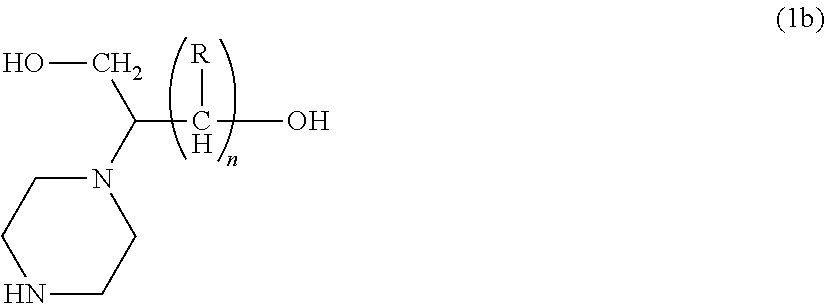Process for producing hydroxyalkyltriethylenediamine, and catalyst composition for the production of polyurethane resin using it
a technology of hydroxyalkyltriethylenediamine and catalyst composition, which is applied in the direction of organic compound/hydride/coordination complex catalyst, physical/chemical process catalyst, organic chemistry, etc., can solve the problems of cumbersome purification, poor productivity, and industrial disadvantage of the process, so as to obtain hydroxyalkylpiperazine simply and safely, obtain hydroxyalkylpiperazine simply and efficiently, and achieve the effect of simple and safe production
- Summary
- Abstract
- Description
- Claims
- Application Information
AI Technical Summary
Benefits of technology
Problems solved by technology
Method used
Image
Examples
preparation example 1
Preparation of Dihydroxypropylpiperazine
[0219]Into a 200 ml three-necked flask, 86.1 g (1.0 mol) of piperazine and 100 ml of methanol as a solvent were charged, and in a nitrogen atmosphere, 22.2 g (0.3 mol) of glycidol was dropwise added over a period of 4 hours. The three-necked flask was held in an oil bath, and the temperature of the reaction solution was maintained at 60° C. After completion of the dropwise addition of glycidol, methanol as the solvent and unreacted piperazine in the reaction solution were distilled off by simple distillation. The product was vacuum-dried to obtain 45.2 g of a white viscous solid. This substance was confirmed to be dihydroxypropylpiperazine represented by the above formula (3a) (hereinafter referred to as DHPP-3a) by the gas chromatography mass analysis and the nuclear magnetic resonance analysis.
preparation example 2
Preparation of Dihydroxypropylpiperazine
[0220]86.1 g (1.0 mol) of piperazine, 92.1 g (1.0 mol) of glycerin, 5.0 g of aluminum phosphate (manufactured by Wako Pure Chemical Industries, Ltd., for chemical application) as a catalyst and 600 ml of water as a solvent were charged into a 1,000 ml autoclave and heated to 280° C. in a nitrogen atmosphere. At that time, the reactor pressure was 6.0 MPa (gauge pressure, the same applies hereinafter). The reaction time was 2 hours. After completion of the reaction, water as a solvent, unreacted piperazine, glycerin and by-products in the reaction solution were distilled off by distillation to obtain a desired product (white viscous solid: 16.4 g). This substance was confirmed to be DHPP-3a by the gas chromatography mass analysis and the nuclear magnetic resonance analysis.
preparation example 3
Preparation of Dihydroxypropylpiperazine
[0221]86.1 g (1.0 mol) of piperazine, 55.3 g (0.5 mol) of chloropropanediol and 200 ml of methanol as a solvent were charged into a 500 ml three-necked flask and heated to 60° C. in a nitrogen atmosphere. At that time, the reactor pressure was the atmospheric pressure. The reaction time was 16 hours. After completion of the reaction, a sodium hydroxide aqueous solution having a concentration of 5 mol / L (100 ml) was added for phase separation of the reaction solution, whereupon the product contained in the organic layer was extracted with 1-butanol. Water as a solvent, unreacted piperazine and by-products in the reaction solution were distilled off by distillation to obtain the desired product (white viscous solid: 56.1 g). This substance was confirmed to be DHPP-3a by the gas chromatography mass analysis and the nuclear magnetic resonance analysis.
PUM
| Property | Measurement | Unit |
|---|---|---|
| Time | aaaaa | aaaaa |
| Time | aaaaa | aaaaa |
| Percent by mass | aaaaa | aaaaa |
Abstract
Description
Claims
Application Information
 Login to View More
Login to View More - R&D
- Intellectual Property
- Life Sciences
- Materials
- Tech Scout
- Unparalleled Data Quality
- Higher Quality Content
- 60% Fewer Hallucinations
Browse by: Latest US Patents, China's latest patents, Technical Efficacy Thesaurus, Application Domain, Technology Topic, Popular Technical Reports.
© 2025 PatSnap. All rights reserved.Legal|Privacy policy|Modern Slavery Act Transparency Statement|Sitemap|About US| Contact US: help@patsnap.com



